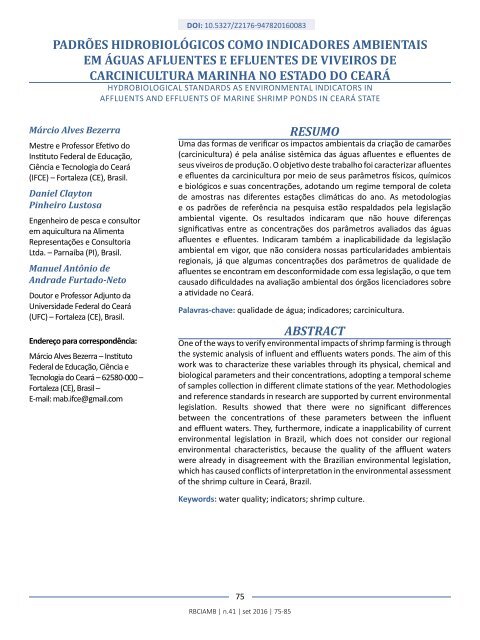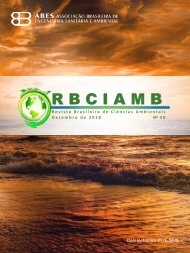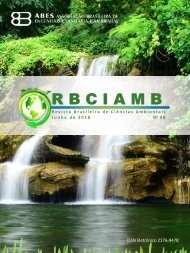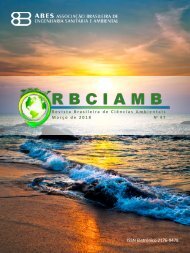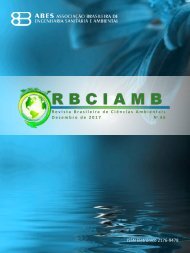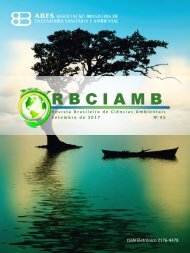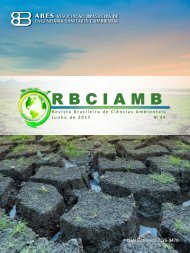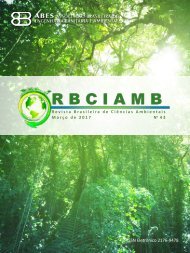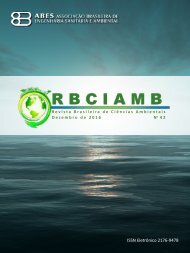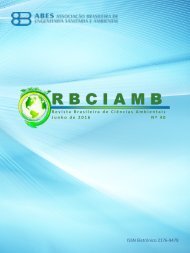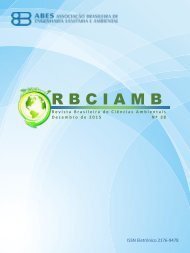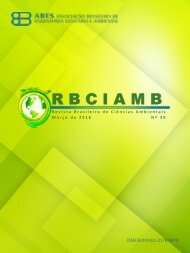EDIÇÃO 41 RBCIAMB
Create successful ePaper yourself
Turn your PDF publications into a flip-book with our unique Google optimized e-Paper software.
DOI: 10.5327/Z2176-947820160083<br />
PADRÕES HIDROBIOLÓGICOS COMO INDICADORES AMBIENTAIS<br />
EM ÁGUAS AFLUENTES E EFLUENTES DE VIVEIROS DE<br />
CARCINICULTURA MARINHA NO ESTADO DO CEARÁ<br />
HYDROBIOLOGICAL STANDARDS AS ENVIRONMENTAL INDICATORS IN<br />
AFFLUENTS AND EFFLUENTS OF MARINE SHRIMP PONDS IN CEARÁ STATE<br />
Márcio Alves Bezerra<br />
Mestre e Professor Efetivo do<br />
Instituto Federal de Educação,<br />
Ciência e Tecnologia do Ceará<br />
(IFCE) – Fortaleza (CE), Brasil.<br />
Daniel Clayton<br />
Pinheiro Lustosa<br />
Engenheiro de pesca e consultor<br />
em aquicultura na Alimenta<br />
Representações e Consultoria<br />
Ltda. – Parnaíba (PI), Brasil.<br />
Manuel Antônio de<br />
Andrade Furtado-Neto<br />
Doutor e Professor Adjunto da<br />
Universidade Federal do Ceará<br />
(UFC) – Fortaleza (CE), Brasil.<br />
Endereço para correspondência:<br />
Márcio Alves Bezerra – Instituto<br />
Federal de Educação, Ciência e<br />
Tecnologia do Ceará – 62580-000 –<br />
Fortaleza (CE), Brasil –<br />
E-mail: mab.ifce@gmail.com<br />
RESUMO<br />
Uma das formas de verificar os impactos ambientais da criação de camarões<br />
(carcinicultura) é pela análise sistêmica das águas afluentes e efluentes de<br />
seus viveiros de produção. O objetivo deste trabalho foi caracterizar afluentes<br />
e efluentes da carcinicultura por meio de seus parâmetros físicos, químicos<br />
e biológicos e suas concentrações, adotando um regime temporal de coleta<br />
de amostras nas diferentes estações climáticas do ano. As metodologias<br />
e os padrões de referência na pesquisa estão respaldados pela legislação<br />
ambiental vigente. Os resultados indicaram que não houve diferenças<br />
significativas entre as concentrações dos parâmetros avaliados das águas<br />
afluentes e efluentes. Indicaram também a inaplicabilidade da legislação<br />
ambiental em vigor, que não considera nossas particularidades ambientais<br />
regionais, já que algumas concentrações dos parâmetros de qualidade de<br />
afluentes se encontram em desconformidade com essa legislação, o que tem<br />
causado dificuldades na avaliação ambiental dos órgãos licenciadores sobre<br />
a atividade no Ceará.<br />
Palavras-chave: qualidade de água; indicadores; carcinicultura.<br />
ABSTRACT<br />
One of the ways to verify environmental impacts of shrimp farming is through<br />
the systemic analysis of influent and effluents waters ponds. The aim of this<br />
work was to characterize these variables through its physical, chemical and<br />
biological parameters and their concentrations, adopting a temporal scheme<br />
of samples collection in different climate stations of the year. Methodologies<br />
and reference standards in research are supported by current environmental<br />
legislation. Results showed that there were no significant differences<br />
between the concentrations of these parameters between the influent<br />
and effluent waters. They, furthermore, indicate a inapplicability of current<br />
environmental legislation in Brazil, which does not consider our regional<br />
environmental characteristics, because the quality of the affluent waters<br />
were already in disagreement with the Brazilian environmental legislation,<br />
which has caused conflicts of interpretation in the environmental assessment<br />
of the shrimp culture in Ceará, Brazil.<br />
Keywords: water quality; indicators; shrimp culture.<br />
75<br />
<strong>RBCIAMB</strong> | n.<strong>41</strong> | set 2016 | 75-85


